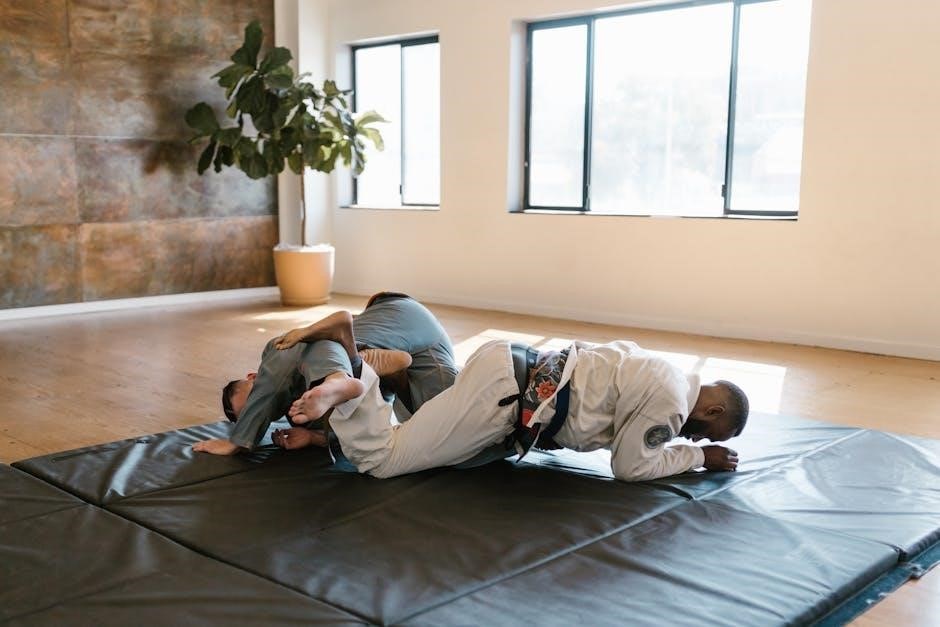The 5-4-3-2-1 grounding technique is a mindfulness exercise that helps individuals focus on the present by engaging all five senses. It’s a simple yet effective tool for managing anxiety and stress by grounding oneself in reality.
What is the 5-4-3-2-1 Grounding Technique?
The 5-4-3-2-1 grounding technique is a mindfulness exercise designed to help individuals focus on the present moment by engaging all five senses. It involves identifying specific elements in one’s surroundings: 5 things you can see, 4 things you can touch, 3 things you can hear, 2 things you can smell, and 1 thing you can taste. This structured approach helps calm the mind, reduce anxiety, and anchor oneself in reality. It’s often used as a tool for managing stress and promoting mental clarity by shifting focus away from overwhelming thoughts and toward tangible sensory experiences.
Why is it called the 5-4-3-2-1 technique?
The 5-4-3-2-1 grounding technique is named for its structured countdown approach, engaging the five senses to anchor oneself in the present. Starting with 5 things you can see, it systematically reduces the focus to 4 things you can touch, 3 things you can hear, 2 things you can smell, and finally 1 thing you can taste. This countdown creates a clear, easy-to-follow routine, making it accessible and memorable. The technique’s name reflects its methodical nature, designed to ground individuals in reality and calm their minds during moments of anxiety or stress.

The Benefits of the 5-4-3-2-1 Grounding Technique
The 5-4-3-2-1 technique offers numerous benefits, including reducing anxiety and stress by focusing on the present. It enhances mindfulness and provides a sense of calm, making it an effective tool for emotional regulation.
How it helps with anxiety and stress
The 5-4-3-2-1 grounding technique is a powerful tool for alleviating anxiety and stress. By focusing on sensory details, it distracts the mind from overwhelming thoughts, providing a sense of control. This method interrupts the cycle of negative thinking, allowing individuals to reconnect with their surroundings. Regular practice enhances emotional resilience, making it easier to manage stressful situations. Its simplicity makes it accessible anywhere, offering quick relief during anxiety attacks or moments of heightened tension, promoting calm and stability in a chaotic environment.
Its role in mindfulness and present-moment awareness
The 5-4-3-2-1 grounding technique plays a significant role in cultivating mindfulness and present-moment awareness. By systematically engaging each of the five senses, individuals focus on their immediate environment, breaking the cycle of mental distraction. This practice encourages a deeper connection with the here and now, fostering clarity and calm. Regular application enhances self-awareness, making it easier to stay grounded during daily activities. It serves as a practical method for integrating mindfulness into everyday life, promoting emotional balance and mental well-being through intentional focus on sensory experiences.
Why it is effective for grounding
The 5-4-3-2-1 grounding technique is effective because it creates a mental anchor to the present moment. By systematically engaging the five senses, it distracts the mind from anxious thoughts. This structured approach helps individuals focus on tangible, immediate experiences, making it easier to break free from mental overload. The technique’s simplicity and accessibility make it a practical tool for grounding in any situation. It effectively interrupts stress cycles and promotes emotional balance by shifting attention to the physical environment, reinforcing a sense of control and calm.

How to Practice the 5-4-3-2-1 Grounding Technique
Start by identifying 5 things you can see, then 4 things you can touch, 3 things you can hear, 2 things you can smell, and 1 thing you can taste. Focus on each category sequentially, paying attention to details. This structured approach helps anchor your mind in the present, providing a calming and grounding experience. Practice regularly to enhance mindfulness and reduce stress effectively.
Step-by-step guide to the exercise
Step-by-Step Guide to the Exercise
Begin by finding a comfortable position, either standing or sitting, and take a deep breath to center yourself. Focus on your surroundings without judgment.
Start with 5 things you can see, such as objects, colors, or patterns around you. Notice details like shapes and textures.
Next, identify 4 things you can touch, like your feet on the ground, the chair beneath you, or the air on your skin. Engage with the sensations.
Then, listen for 3 things you can hear, such as sounds nearby or in the distance, focusing on their volume and clarity.
Continue by noticing 2 things you can smell, like scents in the air or familiar aromas, taking deep breaths to enhance the experience.
Finally, acknowledge 1 thing you can taste, such as a sip of water, gum, or the natural flavor of your mouth.
Repeat the process if needed, allowing yourself to fully immerse in each sensory experience. This structured approach helps calm the mind and ground the body in the present moment. Regular practice enhances its effectiveness in managing stress and anxiety.
Examples of things to notice in each category
For sight, notice objects like flowers, paintings, or furniture details. For touch, consider textures like soft fabrics, rough tree bark, or the warmth of sunlight. Sounds might include a clock ticking, birds chirping, or distant traffic. Smells could be freshly brewed coffee, scented candles, or the earthy aroma of grass. For taste, focus on flavors like a sip of tea, a piece of candy, or the sweetness of a ripe fruit. These examples help anchor your focus, making the grounding technique more effective and personal to your environment. Regular practice enhances your ability to engage with these sensory details.
Tips for focusing on small details
To enhance your grounding practice, start by slowing down and observing minutiae. For instance, notice the intricate patterns on a leaf or the texture of a carpet. Pay attention to subtle sounds, like the hum of an appliance or the rustle of papers. When identifying smells, consider the intensity and origin, such as whether a scent is sweet or earthy. For touch, explore variations in temperature or texture, like the coolness of a breeze or the roughness of bark. These small details help deepen mindfulness and engagement with your surroundings, making the technique more impactful. Regular practice improves your ability to focus and stay present. By training your senses to notice the little things, you can better anchor yourself in the moment, reducing anxiety and stress effectively. This method is particularly useful in overwhelming situations, providing a quick and accessible way to regain control of your emotions and thoughts. Over time, it becomes second nature, offering a reliable tool for maintaining calm and clarity in daily life. The key is consistency and patience, allowing the technique to become an instinctive response to challenging moments.

5 Things You Can See
Examples of things to observe
Identify five things you can see, such as flowers, paintings, lamps, clouds, or furniture. Observing these details helps you stay present and focused.
- Flowers
- Paintings
- Lamps
- Clouds
- Furniture
When practicing the 5-4-3-2-1 grounding technique, focus on five distinct things you can see. These might include nature elements like trees, birds, or clouds, or indoor objects like books, rugs, or decorative items. Notice the colors, shapes, and textures of these items. For example, observe the patterns on a rug, the vibrant hues of flowers, or the intricate details of a painting. Paying attention to these visual details helps anchor your mind in the present moment and distracts from overwhelming thoughts.
- Trees
- Birds
- Clouds
- Books
- Rugs
How to practice visual grounding
To practice visual grounding, start by slowing down and intentionally focusing on your surroundings. Scan your environment, noticing textures, colors, and shapes. For example, observe the intricate patterns on a leaf, the way light reflects off a surface, or the vibrant hues of a painting. Avoid rushing—take your time to truly see each detail. This practice helps calm the mind by anchoring you in the present moment. The goal is not to analyze but to observe, allowing yourself to fully engage with what you see. Regular practice enhances mindfulness and reduces anxiety.

4 Things You Can Touch
- A soft cushion or chair for comfort.
- The texture of a wooden table or fabric.
- The ground beneath your feet or grass.
- A cool surface, like a window or metal object.
Examples of textures and objects
The 5-4-3-2-1 technique encourages you to explore textures and objects around you. Examples include:
- Soft fabrics like a plush rug or cozy blanket.
- Rough textures such as tree bark or stone walls.
- Gentle surfaces like a feather or flower petal.
- Cool objects, such as a metal doorknob or ceramic tile.
- Smooth surfaces like glass or polished wood.
These tangible elements help you focus on the present moment and anchors your senses to reality.
How to practice tactile grounding
To practice tactile grounding, start by identifying four objects within reach. Gently touch each one, focusing on their texture, temperature, and weight. For example, run your fingers over a soft blanket, then a smooth table surface. Next, touch something rough, like a tree bark or a woven basket. Finally, engage with a cool object, such as a metal railing or a glass vase. This deliberate exploration of textures helps anchor your mind in the present moment, reducing anxiety and fostering calm awareness.

3 Things You Can Hear
Examples of sounds to notice
Notice three distinct sounds, such as birds chirping, a clock ticking, or someone speaking. Focus on their pitch, volume, and source to enhance auditory grounding.
Identify three distinct sounds in your environment, such as birds chirping, a clock ticking, or footsteps nearby. You might also notice background conversations, traffic noise, or the hum of an appliance. Pay attention to the pitch, volume, and source of each sound. For example, in a park, you might hear leaves rustling, children laughing, or a distant dog barking. Indoors, sounds like a fan running, keys typing, or water flowing can be focal points. These auditory cues help anchor your mind to the present moment, enhancing your grounding experience.
How to practice auditory grounding
Begin by closing your eyes and taking a deep breath. Focus on the first sound you notice, identifying its source and characteristics. Gradually shift your attention to a second sound, then a third. For example, a bird chirping, a car passing, and a clock ticking. Note the differences in pitch, volume, and rhythm. Open your eyes slowly, maintaining awareness of these sounds. This practice enhances mindfulness and helps you stay grounded by connecting with your auditory environment. Regular practice improves your ability to focus and reduces anxiety by anchoring you in the present.

2 Things You Can Smell
Identify two distinct scents, such as freshly brewed coffee or the earthy aroma of cut grass. Focus on their intensity and origin to enhance grounding.
Examples of scents to identify
Common scents include freshly brewed coffee, baked goods, or essential oils. Natural aromas like cut grass, blooming flowers, or the earthy smell after rain are also effective. Household scents such as cleaning products, candles, or cooking spices can be identified; Even subtle smells like leather, wood, or fabric can serve as grounding cues. The key is to focus on distinct, recognizable fragrances that bring clarity and calmness to the moment.
How to practice olfactory grounding
Start by closing your eyes and taking a deep breath. Inhale slowly, focusing on any scents present in your environment. Identify two distinct smells, such as coffee brewing or fresh flowers. Note their intensity and origin. Reflect on how these aromas make you feel. Open your eyes and jot down the scents, enhancing mindfulness. This practice sharpens your sense of smell and grounds you in the present, offering a calming escape from overwhelming thoughts.

1 Thing You Can Taste
Examples of tastes to focus on
Focus on one taste, like a mint or coffee. Notice its flavor and texture. This grounding step connects you to the present moment quickly.
Examples of tastes include mint, coffee, tea, or a piece of candy. Focus on the flavor, sweetness, or bitterness. Notice how the taste changes as you savor it. This step helps anchor you in the present moment by engaging your sense of taste. Common examples are chewing gum, a sip of water, or even the aftertaste of food. The goal is to fully experience the sensation, allowing it to ground you effectively. This simple act can quickly bring clarity and calmness;
How to practice gustatory grounding
To practice gustatory grounding, choose something with a distinct taste, like mint gum or a sip of coffee. Place it in your mouth and focus on the flavor. Notice its sweetness, bitterness, or tanginess; Savor the taste slowly, paying attention to how it changes as you experience it. This exercise helps anchor you in the present moment by engaging your sense of taste. Even a simple sip of water can be effective. The goal is to fully immerse yourself in the sensation, allowing it to distract from anxious thoughts and ground you in reality.

Real-Life Applications of the 5-4-3-2-1 Technique
The 5-4-3-2-1 grounding technique is widely used to manage anxiety attacks, reduce stress in overwhelming situations, and enhance mindfulness in daily life. It helps individuals stay grounded and calm.
Using it for anxiety attacks
The 5-4-3-2-1 grounding technique is a powerful tool for managing anxiety attacks. By focusing on sensory experiences—5 things seen, 4 touched, 3 heard, 2 smelled, and 1 tasted—it distracts the mind from anxious thoughts. This mental shift reduces panic and promotes relaxation. Many individuals find it effective in calming their nervous system during overwhelming episodes, helping them regain control and stability. The structured approach makes it easy to practice, even during intense anxiety, providing a sense of grounding and connection to the present moment.
Using it for stress management
The 5-4-3-2-1 grounding technique is a practical strategy for managing stress. By engaging the senses, it redirects focus away from stressful thoughts, promoting calm and clarity. This exercise helps individuals remain present, reducing feelings of overwhelm. Regular practice strengthens emotional resilience, making it easier to handle daily stressors. Its simplicity and accessibility make it a valuable tool for anyone seeking to maintain mental well-being and reduce tension effectively. Over time, it fosters greater mindfulness, enhancing overall stress management capabilities.
Using it in daily mindfulness practice
The 5-4-3-2-1 grounding technique is an excellent addition to daily mindfulness practice. It encourages individuals to pause, observe their surroundings, and connect with the present moment. By incorporating this exercise into a daily routine, one can cultivate greater awareness and reduce mind-wandering. Its simplicity makes it ideal for quick mindfulness breaks, whether at home, work, or outdoors. Regular practice enhances the ability to stay grounded, fostering a sense of calm and clarity. It complements other mindfulness activities, such as meditation or deep breathing, by providing a structured yet flexible way to engage with the environment.

The Effectiveness of the 5-4-3-2-1 Grounding Technique
The 5-4-3-2-1 grounding technique is a simple yet effective method for managing anxiety and stress. Its structured approach makes it accessible and widely recommended by mental health professionals.
Scientific basis for its effectiveness
The 5-4-3-2-1 grounding technique leverages sensory engagement to activate the brain’s default mode network, reducing anxiety and stress. By focusing on tangible stimuli, it interrupts negative thought cycles, promoting emotional regulation. Studies suggest that mindfulness practices, like this technique, decrease cortisol levels and increase parasympathetic activity, fostering relaxation. Its structured approach ensures consistent results, making it a scientifically supported method for grounding and mental well-being.
How it compares to other grounding techniques
The 5-4-3-2-1 technique stands out due to its structured, multi-sensory approach, distinguishing it from other grounding methods. Unlike techniques that focus on a single sense, this method engages all five, providing a comprehensive grounding experience. It is more systematic than deep breathing exercises and quicker to apply than progressive muscle relaxation. Additionally, its simplicity makes it more accessible than complex visualization practices. This unique combination of breadth and ease of use sets it apart as an effective and efficient tool for grounding.
Success stories and testimonials
Many individuals have shared positive experiences with the 5-4-3-2-1 grounding technique, describing it as life-changing and effective for managing anxiety and stress. Users often highlight its simplicity and accessibility, making it a go-to tool in overwhelming situations. One testimonial noted how the technique quickly calmed panic attacks, while another praised its ability to bring clarity during stressful moments. Others appreciate its versatility, using it not only for anxiety but also as part of daily mindfulness routines. The consistent positive feedback underscores its effectiveness in grounding and promoting emotional balance.
The 5-4-3-2-1 grounding technique is a simple, effective method for managing anxiety and stress by focusing on sensory awareness, proving its value in daily mindfulness practice.
The 5-4-3-2-1 grounding technique is a mindfulness exercise that engages all five senses to bring focus to the present moment. It involves identifying five things you can see, four things you can touch, three things you can hear, two things you can smell, and one thing you can taste. This structured approach helps individuals anchor themselves in reality, making it an effective tool for managing anxiety, stress, and overwhelming emotions. By intentionally connecting with sensory experiences, the technique promotes calmness and clarity, enhancing overall mental well-being.
Final thoughts on its importance
The 5-4-3-2-1 grounding technique is a powerful mindfulness tool that empowers individuals to regain control over their emotions and thoughts. Its simplicity and accessibility make it universally applicable, allowing anyone to practice it anywhere, anytime. By fostering present-moment awareness, it helps reduce anxiety, stress, and feelings of overwhelm. This technique not only promotes emotional resilience but also enhances overall mental well-being. Its effectiveness lies in its ability to distract the mind from negative thoughts and reconnect it with the physical environment, making it an indispensable practice for maintaining emotional balance in daily life.

